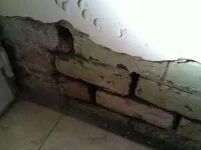windy
Private Member
Right
Mother in laws job part 2
Removed skirt and found 3 main probs
Backing plaster was all the way down to the floor (and damp)
Pointing is completely goosed (as you can see)
There is a void to the bottom left internal where the wall meets the door
My plan of action was as follows:
Plug internal void with expanding foam
Re point brickwork with s&c
Inject dpc into bottom course once pointing has dried (dryzone)
Apply bonding
Skim
any ideas?
Mother in laws job part 2
Removed skirt and found 3 main probs
Backing plaster was all the way down to the floor (and damp)
Pointing is completely goosed (as you can see)
There is a void to the bottom left internal where the wall meets the door
My plan of action was as follows:
Plug internal void with expanding foam
Re point brickwork with s&c
Inject dpc into bottom course once pointing has dried (dryzone)
Apply bonding
Skim
any ideas?

